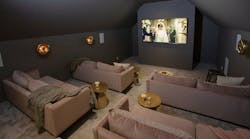The suburban sprawl that occurred in the 1950s and 60s led to new styles of homes, new styles of furnishings and materials, and a new place to hang out—downstairs, if the foundation included a basement level.
Over time, homeowners upgraded the basement moniker to a recreation room as it became a nicer place for informal living, sometimes with a fireplace, bar, ping-pong, or billiards table, and better building materials to camouflage cinderblock walls, concrete floors, acoustical ceiling tiles, and exposed ductwork.
Yet, rec rooms were not appraised at the same value as the rest of the home’s square footage—no matter how nice— because of its below grade location. “The biggest reason is that few have exterior windows even if finished and heated. If it does have those, it might generate a higher appraisal,” says Madison, Conn.-based architect and author Duo Dickinson.
Now with the pandemic bringing families together more, having a rec room has taken on greater importance, and clients are likely to spend money on the room and its trappings. “Basements have always been popular but now more than ever, as long as they don’t flood!” says real estate salesperson Stephanie Mallios with Compass Real Estate New Jersey.
Ping pong hangout by Morgante Wilson Architects. | Photo: Werner Straube
What Affects the Price Tag
Another prime reason for the popularity surge is that it typically costs less per-square-foot to convert a lower-level space rather than add or remodel upstairs. Nevertheless, clients may still be surprised by estimates once you total up lighting, wiring, and new materials, says Dickinson.
And what may really send the price soaring is if they ask you to dig down to gain height since many basements have shallow ceilings, says architect Julie Hacker of Stuart Cohen and Julie Hacker Architects in Evanston, Ill.
Location Variables
When the cost is too exorbitant or the downstairs has little natural light, some homeowners will look to you for ways to find space upstairs by converting a room or adding on.
Laurel Vernazza of The Plan Collection, an online source for house plans, noted greater interest in upstairs rec rooms even before the pandemic for homeowners with house plans lacking a basement and measuring at least 3,000 square feet. Some underutilized dining rooms are also taking on this function, she says.
Home builder and interior designer Anna Lowder of Mercer Home in Montgomery, Ala., has constructed recreational rooms on the second level of some homes at its 416-acre Hampstead community to take advantage of unused roof space. She furnished the first one—part of a model home—for watching movies. It proved so popular that the firm introduced more, and those houses have been among its best sellers, she says.
Theater room by Mercer Homes
Homeowner Scott Seifert, who lives in College Park, Penn., where the state university is located, also converted his unfinished attic. “I am a huge sports fan and living in a town that lives and breathes college football, I knew our home needed a well-designed, accessible rec room since we host so many people. The basement was only accessible through an outdoor entrance, and the layout didn’t provide the framework for what I was envisioning,” says Seifert, a mechanical engineer.
Homeowners are also looking to their garages and outbuildings for options. Architect Bob Zuber, AIA, a partner at Morgante Wilson Architects in Evanston, Ill., designed a bicycle lounge for one avid cyclist client in a garage. He’s also designed sports courts, movie theaters, pools, squash courts, bowling alleys, and billiards. “About 95% of our projects this year have included some type of recreational space wherever it’s located,” he says.
To be sure it’s used and adds value, Vernazza suggests choosing building materials and an overall design reflective of the home’s other rooms.
Four Key Questions to Ask
Take steps to protect your client’s investment by asking clients the following questions, especially if a lower-level space:
1. Is water an issue? Be sure the location will remain dry. Ask clients about the history of water entering. If there’s a potential problem, waterproof walls, floor, and foundation and discuss adding a sump pump and French drains.
In certain cases, it may prove worthwhile—also more expensive—to dig away from the existing foundation and add a membrane to the outside to keep away groundwater, and consider adding a dehumidification system and generator in case power fails, Dickinson says. You also should talk with clients about installing materials that best withstand water such as engineered wood flooring and vinyl tiles rather than solid hardwood, Zuber says.
2. How comfortable will the room be for living? Depending on its use, homeowners may want to close off the room for privacy with barn, pocket, or folding doors and add soundproofing materials to control noise, says Zuber.
If it’s on the basement level, be sure the ceiling height is not too low—preferably above 8 1/2’. Also ensure the room’s temperature will be comfortable and the room well ventilated. Some spaces may need more insulation in walls and floors, Dickinson says. Plentiful artificial or natural light is important, too, since many lower levels have only small windows, he says.
3. Is plumbing needed? Adding plumbing can be costly, especially on a lower level, so ask homeowners about the importance of a bathroom and other features before installing lines, Zuber says. Though Dickinson thinks having a sink is wise.
4. Is the room safe? Depending on local building codes, a second way to get out is necessary, such as a big enough window or second stair, Dickinson says. Also, check—and correct if necessary—radon levels before improving the space.
About the Author

Barbara Ballinger
Barbara Ballinger, is a writer who focuses on real estate, design, and personal subjects. Her latest book is Not Dead Yet: Rebooting your life after 50.


